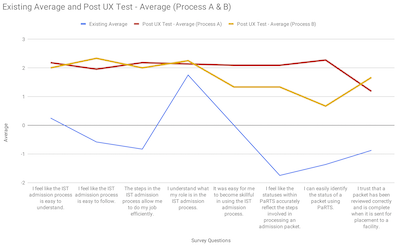DSH Pre-Admissions
2019-03-08 00:00:00 +0000 - Chaeny Emanavin

Tl;dr - DSH had an urgent need to reduce the amount of time it took to admit patients into facilities as part of the incompetitent to stand trial process. The existing process was taking up to six months. The team worked with DSH staff across hospitals and the central office to identify redundancies. The initial prototype reduced the expected time to 70 days. The revised prototype further reduced the expected process down to 21 days.
Department of State Hospitals - Reimagining the Imcompetent to stand trial process
Team Members: Crystal Favareille, Marni Sager, Jacob Johnson, Pindy Kaur, Elizabeth Colegrove
Office of Innovation Director: Chaeny Emanavin
Department Engagement Champion: Catherine Hendon
The Initial Problem
Department of State Hospitals (DSH) provides evaluation and treatment in a safe and responsible manner, by leading innovation and excellence across a continuum of care and settings.
Department of State Hospitals (DSH) requested assistance from the Office of Innovation (OI) to look at its Incompetent to Stand Trial admission process. The Department was involved in pending litigation, with the potential for a resulting mandate to significantly reduce the amount of time from commitment date to admission to a DSH program/state hospital.
The Department had been using a centralized processing unit to handle all incoming referrals and to manage the pre-admission process for all program locations. Through interviews, it was discovered that there was redundant work occurring at different locations and at different levels of the organization, with the existing process. The OI worked with all DSH stakeholders, to create a refined process to increase efficiency by having the centralized admission unit oversee and manage the referral process instead of taking on the entire workload of management, oversight, coordination, and review. The refined process has the potential to shave off a significant number of days from the existing timeframes from commitment to admission.
Discovery
TDuring the discovery phase of our process, we interviewed approximately 40 employees at DSH, and documented a range of perspectives, thoughts, and ideas regarding the challenge space. Our team visited DSH facilities, to observe admissions processes firsthand, and observed the work of staff at DSH headquarters, who coordinate and manage the admissions process.
During the ideation phase, we facilitated workshops in which DSH staff identified and documented the steps in the pre-admissions process. Workshop participants worked out process details and resolved areas of differing perspectives, and estimated the time required to complete each step. The group also brainstormed ideas for ways to make the information systems that support the process better.
New Challenge Statement
How might we most efficiently meet the needs of patients determined incompetent to stand trial (IST) by reducing the number of days between a couty court’s commitment date and the hospital admission date?
Prototyping & Deliverables
In the initial prototyping workshop, DSH staff was asked to generate ideas to address the problem space. Attendees were encouraged to think big, build upon the ideas of others, and to prioritize quantity over quality. For the second workshop, team members considered possible enhancements to the PaRTS system, as they created another set of paper prototypes. The goal was to address pain points and opportunities identified in the previous workshop session and discovery interviews.
Currently the process is down to about 70 days average to admission. The new workflow gets this process down to three weeks or less.
The department has taken the following actions to reduce the time between commitment and admission based on ideas from our engagement, as follows:
- Established a pre-admissions governance structure.
- Created an IST pre-admission workgroup with one rep representative from each hospital, as well as representatives from business areas within headquarters that perform a role in the pre-admissions process
- Converted workflows developed during our engagement into Visio, and are starting to implement policies and procedures to efine roles and responsibilities
- Continuing information sysems enhancements to capture more relevant data
- Considering budget change based on planning work from our engagement
- Planning to conduct a workshop to brainstorm a strategy to implement court mandated changes
- Requested OI to provide additional training workshops in product management, road mapping and change management
- - The staff is already working to integrate these methods into their daily operations and seeing culture change and energy already
- - Include forging new relationships between field and central office
- Journey mapping complex processes with all stakeholders in room makes handoffs visible
- Grouping pain points makes it clear to see where to focus efforts
| We don't need an app for that |
The team also found improvements in unexpected places by emphasizing problem definition. For example, the DSH legal staff repeatedly were asking for an app so they can look up cases while at the courthouse. Dealing with dozens of cases every day, the lawyers had to constantly call the analysts to get up to date status on clients. The OI team worked with the DSH IT shop to better understand the need. They found the problem could be quickly and simply solved by simplifying giving the legal staff remote access. They had this capability but never enabled it because they did not know there was a use case for it. They granted access solving the issues and improving productivity immediately.
What you can use in your Department
The DSH leadership and staff leaned into the tools and techniques:Quotable Quotes
It was helpful for our team to see everything together. We talk about a lot of these items, I think this will help the team not to get bogged down working on something that is more of a downstream task, so we can all focus on the priority items first. I thought the two techniques we used today were very helpful in illustrating this.
"We made exciting progress yesterday. I am very appreciative of the great work you are all doing. It’s really propelling us forward on many fronts. "